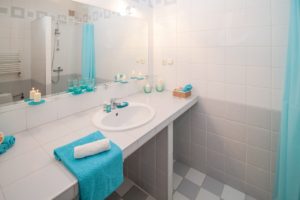 Many do-it-yourself home decorators often have a difficult time choosing light fixtures for the bathroom. If you don’t have enough light, the bathroom looks and feels dreary; it also makes it hard for people to see what they’re doing in their grooming and makeup routines. Having too much light, on the other hand, can create a harsh glare in your bathroom.
Many do-it-yourself home decorators often have a difficult time choosing light fixtures for the bathroom. If you don’t have enough light, the bathroom looks and feels dreary; it also makes it hard for people to see what they’re doing in their grooming and makeup routines. Having too much light, on the other hand, can create a harsh glare in your bathroom.
In other words, your bathroom lighting needs to strike the perfect balance of brightness, aesthetics, and usefulness. Not surprisingly, it’s easy to make mistakes when trying to find this balance of lighting.
Adding Harsh Light Fixtures Above the Mirror
Place a light fixture above the mirror makes sense, right? After all, you want a light source close by when you’re shaving, washing your face, or applying makeup in front of the mirror. But an overhead light above the mirror creates ugly shadows under your eyes, mouth, and nose, which makes it difficult to see your face under an even glow of light.
Instead, position your lights on both sides of the mirror, which will provide a more even glow on your face. You can also hang your mirror on a base smaller than the width and height of your mirror, which will create a gap between it and the wall. Next, place LED strip lights behind the edges of your mirror, which will cast a diffused light on your face.
Too Few Light Sources
Yes, you want to create a space that’s relaxing and comforting, but having too few lights is not the way to do it. A dim bathroom makes it difficult to see what you’re doing and causes eye strain.
To get an estimate of how many lights you need in the bathroom, you’ll first need to figure out how many lumens (the measure of brightness) you need in the space. So, if the bathroom has a floor area of 64 square feet, simply multiply that by a foot-candle range of 70 to 80 (recommended for bathrooms), which means you’ll need a total of 4480 – 5120 lumens in the room.
Now that you know your required lumen range, you need to mix up your light sources instead of just using ceiling lights. Feel free to use wall sconces, pendant lights, and strip lights behind the mirror, which, when all switched on, should generate 4480 to 5120 lumens.
Not Placing Lights in the Shower or Bath Area
Many homeowners make the mistake of not placing lights in the shower or bath area of the bathroom out of fear that the light fixtures will malfunction due to constant exposure to moisture. And so, any light that reaches the shower/bath area usually comes from the vanity area.
To solve this problem, choose water-resistant light fixtures to avoid any moisture damage. In addition, avoid fixtures made from materials like bronze, brass, and fabric, which either rusts or deteriorates from moisture exposure.
When lighting your bathroom, avoid these mistakes to turn it into a real escape worth spending time in.

![Demystifying LED Terminology: 12 Words You Need To Know [city]](https://8blocks.s3-us-west-1.amazonaws.com/eepros/2020/social.jpg)
![Quick Tips for [city] Businesses Looking to Re-Think Their Commercial Lighting Strategy [city]](https://eepros.com/wp-content/uploads/2020/04/team-4503157_640-300x199.jpg)
![LED Lighting Facts [city]](https://8blocks.s3.amazonaws.com/eepros/blog-images/2015/08/led-light-bulbs-300x209.jpg)